How to choose curtains for a nursery?
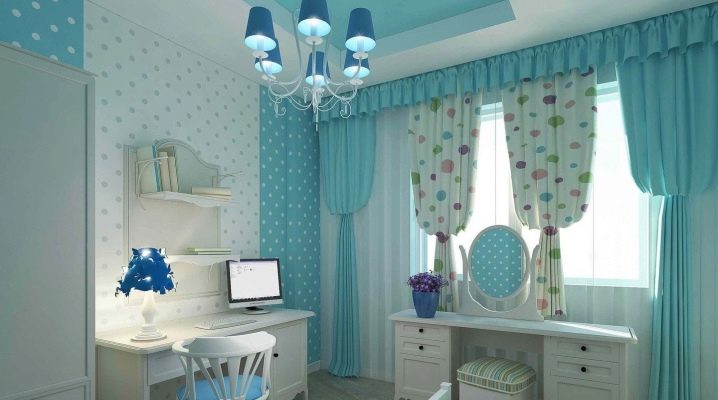
Buying curtains is a fun activity that allows you to unleash your creativity. However, it is one thing to buy curtains for common rooms and the bedroom of adults, and quite another to purchase curtains for the nursery. Let's take a look at how to choose the right stylish and modern models for decorating children's rooms.
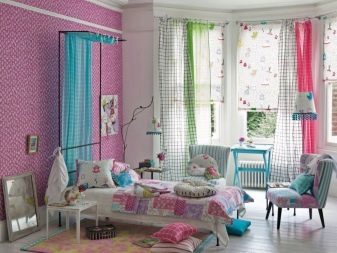

Requirements for curtains for the nursery
Whatever the opinions on the appropriateness of window openings with curtains in the children's bedroom, curtains are really necessary. This is due to the functional loads that products must perform, depending on the type of model and the type of textiles used for its manufacture. For example, curtains should:
- be aesthetically attractive;
- indicate belonging to a particular style of room design;
- protect the room from the abundance of sunlight penetrating inside;
- to hide the interior decoration and the children themselves from prying prying eyes from the street;
- prevent the passage of cold air (important for curtains made of dense fabrics);
- reduce the noise level coming from the street (only for thick curtains).

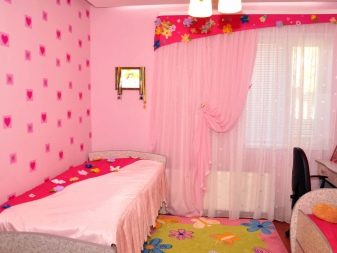
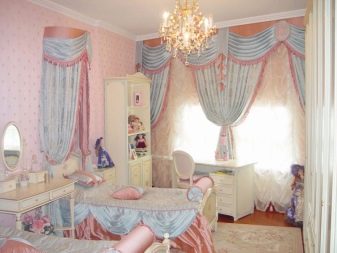
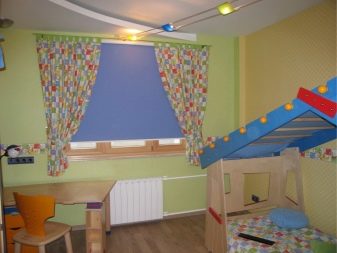
There are also a number of requirements for curtains for children's rooms, for example:
- products must be sewn from fabrics made without toxic dyes;
- curtains must comply with safety standards, having reliable fasteners and high-quality manufacturing;
- panels should be lightweight, not burdening the interior of the nursery;
- their design, texture and theme of the drawing must be selected taking into account the age category of the child;
- curtains should have a convenient opening and closing mechanism, which the child can handle on his own;
- the color of the panels should not carry negative coloring and oppressive atmosphere into the interior;

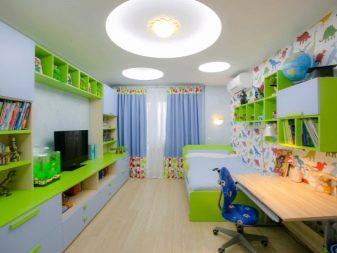

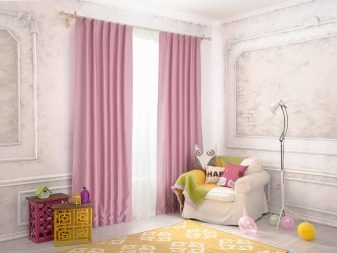
- the print must correspond to the size of the entire room, otherwise the curtains risk distorting the parameters of the child's room;
- the width and length of any product should be sufficient, but not superfluous, an excess of length can provoke a traumatic situation;
- regardless of the model, the product should not interfere with the ventilation of the room;
- the model should be selected in accordance with the type of window and the way it is opened (closed);
- the maximum number of layers in a design should not exceed two.
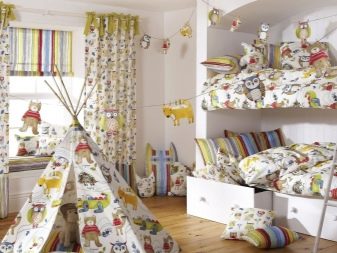
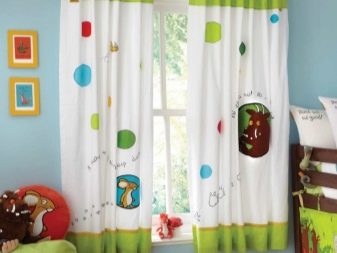
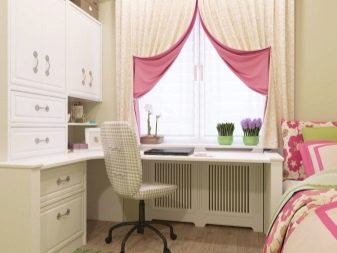
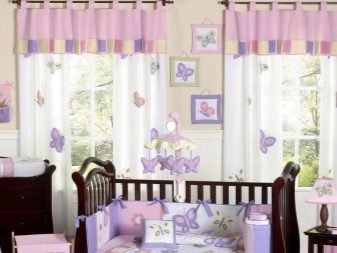
Types
It is difficult to buy curtains, taking into account the desired stylistic direction of design, if you do not have an idea of their varieties. There are so many model options on the modern market that even a sophisticated buyer can get confused. However, from the entire wide range of proposals, you can choose the most interesting and modern solutions that are suitable for decorating children's windows. Let's designate them briefly.
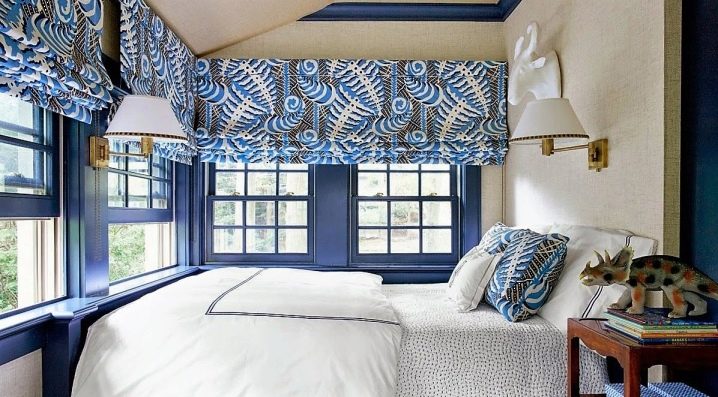
Traditional
This line can include standard rectangular curtains. Their fasteners can be rings, loops (including Velcro) and eyelets, which are especially popular this season. Laconic curtains are convenient because they can be made not only from dense, but also thin textiles. Due to this, they can be divided into two categories: night (dense) and daytime (thin and translucent curtains). If you wish, you can choose such options that will be both independent curtains that close the children's room from prying eyes, and day curtains that serve as window decor.
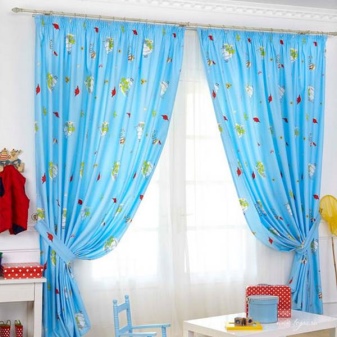
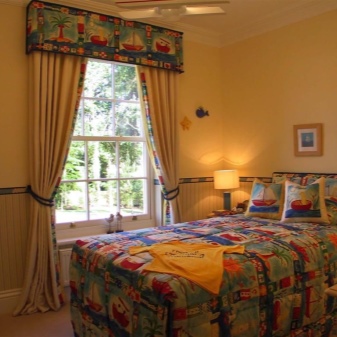
With lambrequin
Such curtains have undergone some changes today. If earlier the lambrequin was complex, today it is made without folds from hard textiles, securely fixing on the sides. Otherwise, it is the same: it is completed by rectangular or rounded fabric panels, which often have hooks with tassels. In general, the models can be considered for purchase in the nursery, however, here you need to take into account the style, age of the child and his gender. Undesirable options with an abundance of draperies at the same time at the top and on the sides.
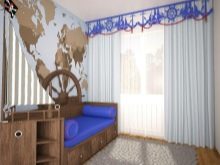
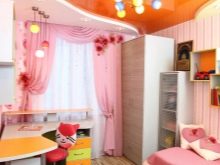
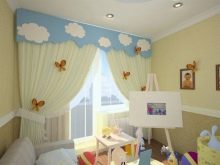
Austrian
Such curtains are nothing more than a rectangular panel of fabric gathered in scallops, regulated by cords threaded inside. At the same time, the assembly and the number of scallops, depending on the type of textiles used, may be different. Austrian curtains look stylish and effective, they can be made of natural and artificial fabrics. However, for such a design, you need to choose models from thin fabrics. The number of scallops allows you to change the perception of models and fit them into the modern style of the interior of the nursery. For example, curtains with one scallop can be used to decorate a room with several small windows in the nursery.
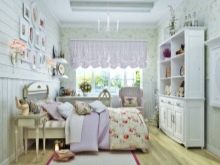
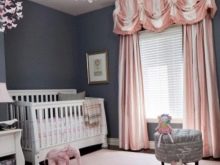

French
Such curtains, called marquises, were introduced into fashion during the reign of Louis XIV, they still retain their popularity. They are distinguished by the softness of the shape and texture of the fabric; their length can be either classic (almost to the floor) or short (covering no more than one third of the window). Unlike Austrian counterparts, French curtains provide for gathering along the entire length of the fabric, while Austrian curtains have it only at the bottom. Such products can be stationary (deaf), without a lifting mechanism, or folding. The second products are remarkable in that they are equipped with a lifting rotor-chain mechanism, due to which it is possible not only to collect festoons, but also to fix them at the desired level.
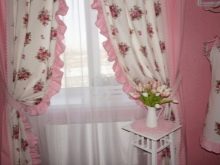
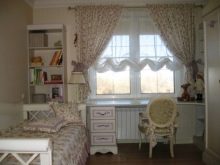
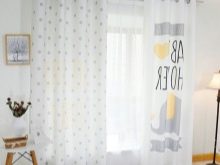
Roller
Roller blinds are a sheet of the size of a window glass, evenly wound on a special shaft. This type of models can have not only manual but also remote control. The shutters are located so close to the glass that they practically have no gaps. Depending on the type of textiles, they can be day or night. By themselves, such products are compact, do not cover the window frame and are quite harmoniously combined with classic curtains on rings or eyelets.
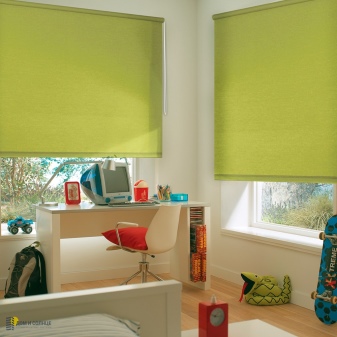
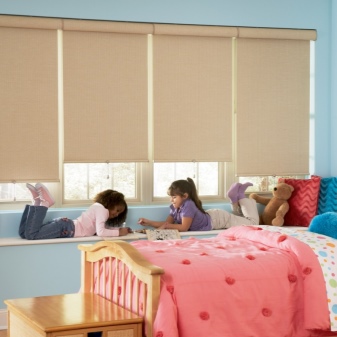
Pleated
These curtains are nothing more than a variety of corrugated shapes. Outwardly, they are somewhat similar to blinds, since they consist of folds identical in length and width, are dense and do not bend when opened, and they fold, forming an even stack of folds. Like roller blinds, they provide manual and remote control. These products are more expensive than roller and classic counterparts, since they are made using a special technology with expensive components. An interesting nuance is the ability to open and close the curtains not only from bottom to top, but also from top to bottom.
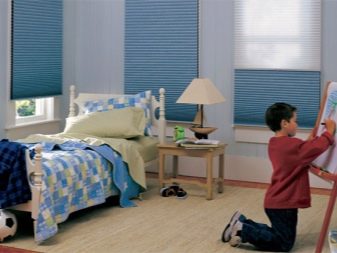
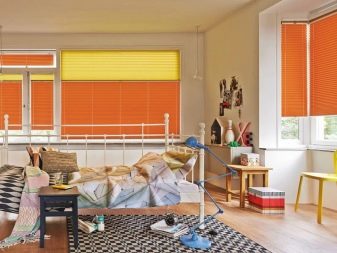
Roman
Such varieties can be safely called an alternative to roller blinds and corrugated type options. They consist of several sections and, like the two previous types of curtains, have weights to create an even and flawless shape. Such curtains are also compact, do not take up much space and, due to their size, create the visual effect of a larger space. Unlike roller and corrugated curtains, such products provide for the replacement of textiles, and they are not as expensive as the two previous options. However, their control is exclusively manual.

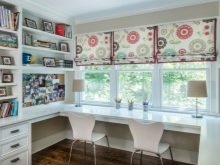
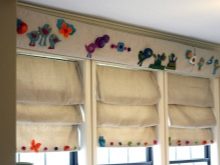
Japanese panels
Perhaps these are one of the most extraordinary solutions for decorating children's windows. Smooth and straight panels do not have folds and folds, they are not even visually similar to screens, partitions, which open according to the principle of compartment doors.At the bottom, to create a flawless shape, they have weights, sometimes their mechanism provides for fastening not only from above, but also from below. Such models look stylish and effective in the interior, however, they are not tied to all stylistic directions of design. If desired, such panels can be used to decorate the rooms of teenagers of both sexes.
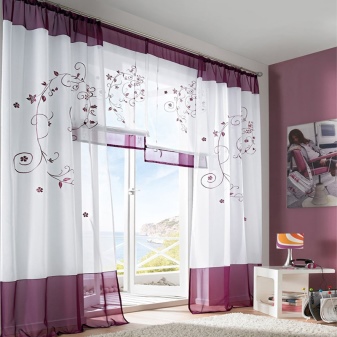
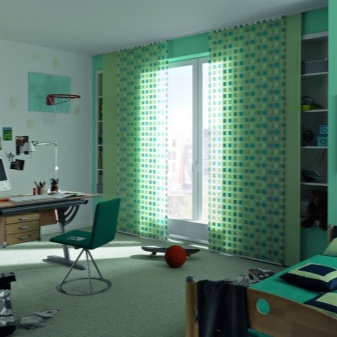
Wooden
Flexible type bamboo curtains can be included in this line. At first glance, they may seem textile, reminiscent of options on rings or eyelets. However, upon closer examination, the layman will see an unusual basis for the products. Other wood curtains are used mainly not for windows, but for decorating doorways. They can be braided and thread. At the same time, for the creation of such products, wood of various species is used, including some varieties of fruit trees. And if bamboo curtains are still capable of performing the main functional loads, thread-type models are rather decorative design elements.
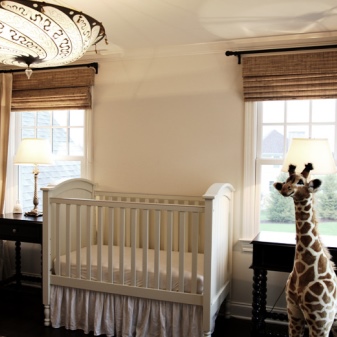

Materials (edit)
Today, manufacturers offer products made from natural and synthetic materials for children's rooms. At the same time, there are no special priorities, although designers pay attention to the fact that heavy materials, which include velveteen and velvet, are not suitable for decorating the windows of children's rooms. It is undesirable to buy tapestry and jacquard products for children's bedrooms. They will not look natural and harmonious in such rooms.
It is better to purchase products made of fabric with a breathable structure.
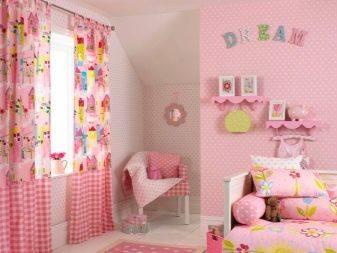
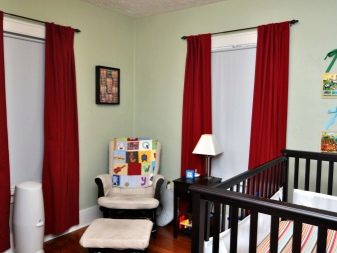
You can decorate the windows with both cotton curtains, matting, gabardine, and polyester curtains. Among the popular materials of this season are linen, calico and satin. However, they are distinguished by high creasing properties. For those who want products that are easier to use and maintain, you can pay attention to canvases made of mixed threads. The addition of synthetics increases the resistance of textiles to fading.
Blackout (opaque canvas) is essentially a curtain fabric with satin weave threads. It differs in density, number of layers and level of light penetration. Such a fabric consists of a woven base (for example, silk, linen, viscose), special chemicals and acrylic foam. Of course, the material is extraordinary, but before buying such curtains, you need to think about their safety for children's health.
Other materials for curtains include flock, the finest veil and organza devore.
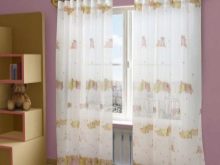
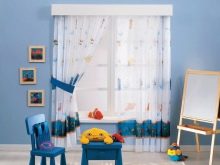
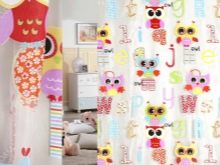
Flock is distinguished by the presence of pile, which gives the curtains an interesting effect. Organza is composed of silk, polyester and viscose yarns. It has a loose base, which shortens its service life. The veil is denser and therefore less transparent. And yet, it is better than organza, does not deform after washing and does not shrink.
Color solutions
Today, the color palette of curtains is so diverse that it allows you to choose not only the desired color and shade, but even its temperature. Parents try to choose tones taking into account the gender of the child, however, do not forget the differences in age groups. For example, if at a young age, parents choose products in pink and blue, teenagers already have their own preferences, including in relation to the color of the curtains. A considerable part of the girls, tired of pink, pay attention to the blue, lilac, beige, milky shades of the color palette.
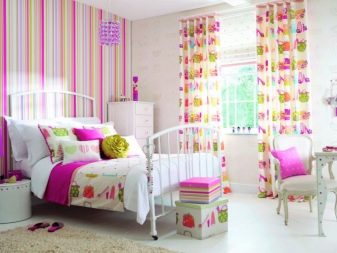
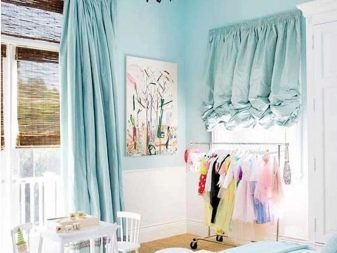

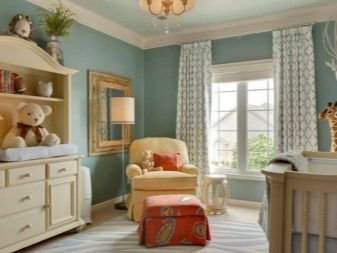
Also popular are mint, caramel, powdery tones, pistachio, turquoise, green and ivory. Boys like the shades of the brown and green group, moreover, they prefer light tones. In addition, young men like sandy yellow, beige, blue, orange, terracotta and neutral (white and gray) shades. The choice of neutral tones is notable for the fact that these colors themselves do not have an emotional coloring, but they acquire it due to the existing interior details.


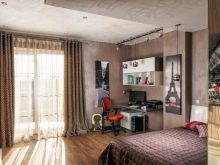
Design
In addition to a variety of models, curtains can be patterned. This allows you to successfully fit them into the existing stylistic direction of the design, indicating its idea. The drawing can be conveyed through images or texture of the material itself, or even by embossing.
For example, prints can be called popular images that adorn curtain panels:
- with butterflies;
- with birds of paradise;
- with owls;
- with stylized branches or trees;
- with leaves separately scattered on the canvas;
- with cartoon characters;
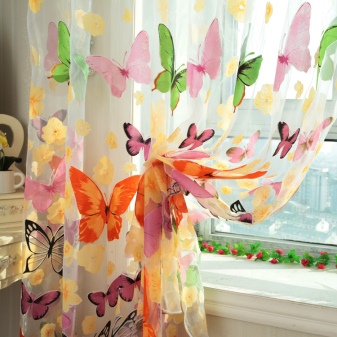
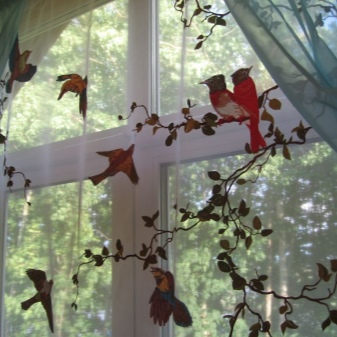
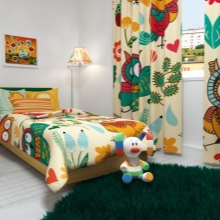
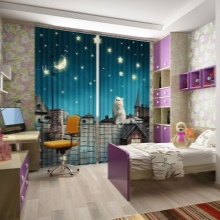
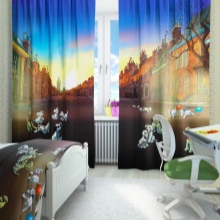
- with cars;
- with floral motives;
- with stars;
- with styling on glamorous and sporty themes.

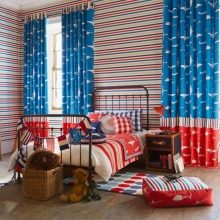
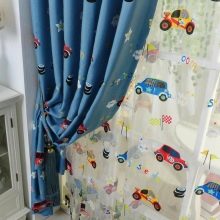
Other decorative elements of curtains that you need to pay attention to are cornices and hooks. Today, wood and metal textures are popular. Curtains that are purchased for specific models should visually match the rods or other mounts. This will contribute to a more harmonious aesthetic perception of the space. Baby room grips don't need huge decorative brushes. It is better if these are accessories that are more familiar to children. For example, you can decorate curtain tiebacks with belt buckles, elastic bands and hairpins. An original decoration technique is embroidery on a veil with an ombre effect. The fabric itself with the effect of a rainbow of tones passing from one to another looks unusual, and the embroidery allows you to give it a special look.
Such curtains are performed on the whole window, because this is how they will look more advantageous.
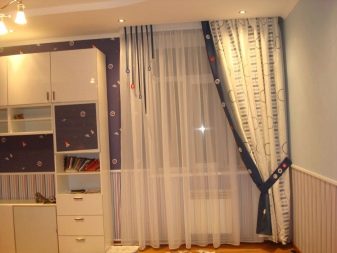
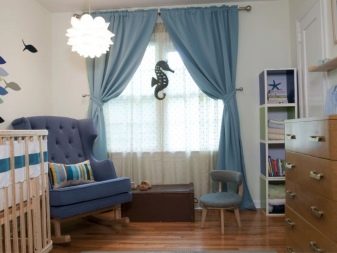
The way of hanging them can be attributed to extraordinary techniques for decorating curtains. Depending on the chosen style and size of the window, the curtains can be hung in different ways. For example, even simple rectangular curtains can be hung crosswise and fixed with hooks, which will already give them an unusual look. Other canvases are decorated with braid with pompoms, sometimes the curtains are even decorated with stickers, due to which it is possible to change the mood that they bring to the interior quite often. The design of curtains for the nursery can be single models or a set of curtains with tulle. Curtains can be bought ready-made or sewn for specific measurements of the windows. You can buy a veil and complement it with night curtains with twinkling stars. This will allow you to change the interior depending on the time of day.
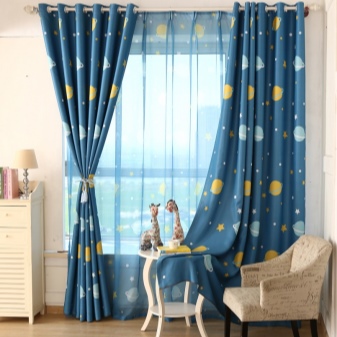
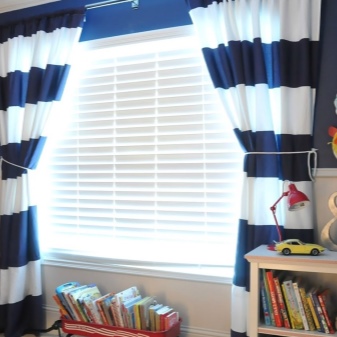
Subtleties of choice
Knowing the basic nuances of the varieties, the principles of color solutions and decoration, it remains to determine the main selection criteria, not forgetting to take into account the effect of color on human perception. For example, when buying ready-made curtain sets for a nursery, you should look closely at curtains with white tulle. White balances out any contrast and even bright tone, making it look softer. If you want to choose a blackout, you should at least roughly understand what substances the intertwined layers are made of. It is undesirable to buy such products in toddlers' bedrooms, even if the room is full of light.
Buy regular tulle and night curtains - that will be enough.
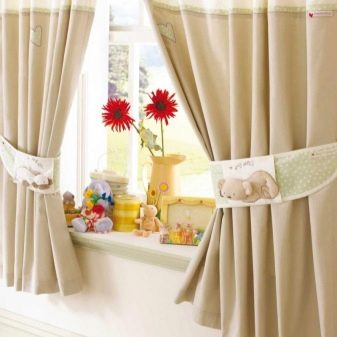
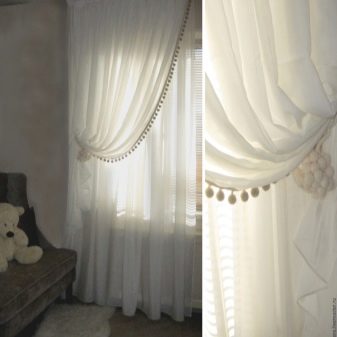
When choosing a color, you need to focus on the details already available in the interior. It can be related to the tone of cushions, carpeting. You should not choose the same color of curtains and bed linen, it is better that the support for the curtains is small. Sometimes the color of the picture frame or its paints is quite enough for this. Curtains in green tones, supported by live greenery, look great. Related tones allow you to add versatility to the interior, which, even with a laconic cut, will look beautiful, stylish and modern. It is better to select multi-colored products using the color wheel. This will allow you to purchase models with a combination of tones that is acceptable to the eyes.
You should not buy curtains to match the wallpaper: this will cause them to be lost on the wall.
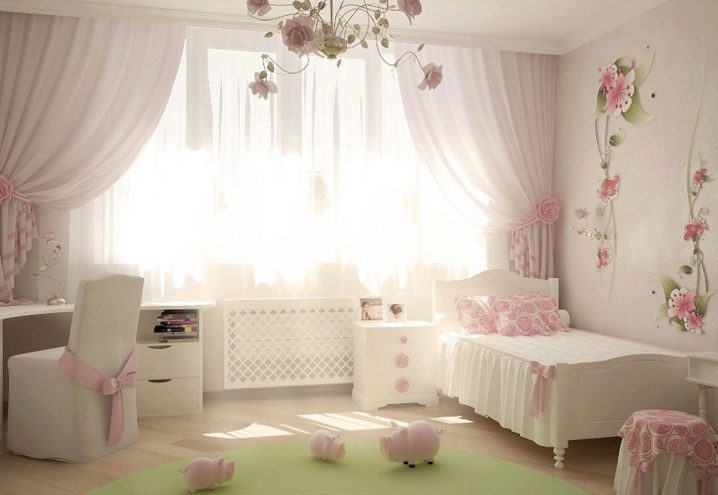
The panels will look more expressive if you buy them in a similar design, accentuating one of the nursery areas (for example, bedroom or playroom).For example, it can be a panel above the writing table, a poster, or even a child's drawing. Taking something from such an accent (say, color, drawing technique, its theme and mood), one can express the hobbies of an already grown-up child. For the attic, which today is often made out for a nursery, you can take blinds, pleated options or classics. Since the windows in such a room are often inclined or even horizontal, you will have to think over fastenings for the panels so that they do not hang perpendicular to the floor. If you want to buy long curtains with eyelets, it is enough to select the lower bar for them in the same design with the cornice to intercept the hanging canvases, covering the windows with fabric. Such window openings are perfectly closed by remote-controlled blinds.
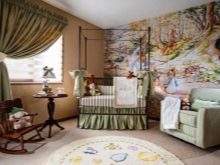
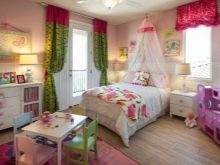

Dimensions (edit)
The dimensions of this or that product may be different. And the point here is not so much in the standards as in the features of the window structures themselves, as well as the types of curtains. For example, roller blinds must match the size of the window glass so as not to have a gap and reliably shelter children from unnecessary human glances. The sizes of corrugated and roman blinds can cover the window frame.
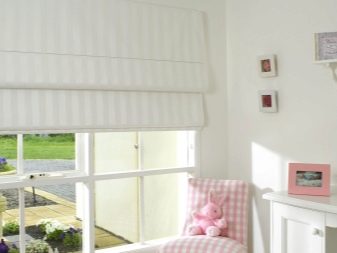

When you plan to buy classic products with rings, eyelets or loops, you need a margin of width so that the curtains have light folds when closed. Usually, the calculations are based on the parameters of a particular window. For classic options on rods, you need to know the length of the cornice, the material build ratio and the allowance for processing side cuts. At the same time, as a rule, for products made of thin materials and options with folds, the coefficient is higher.
The curtains can be of any length: in the traditional version, it does not reach the floor 3 cm. The coefficient for tulle, organza, veils is from 2 to 4: the width of such curtains can be 2, 3 or even 4 times greater than the available length of the cornice. The coefficient for silk, linen, blended fabrics is 2-2.5, and for thicker materials it does not exceed 1-1.5. For models with a pattern, it is minimal (otherwise the print will be distorted).
Standard sizes can be 200x260, 300x260, 500x140, 200x140, 300x140 cm.

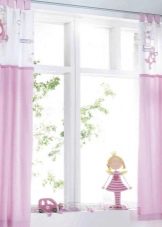

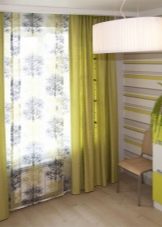
Depending on the gender and age of the child
If we briefly outline the differences between the models of curtains for girls 'and boys' rooms, taking into account their age, then pink tones are alien to boys (this causes discomfort on a subconscious level). For children, it is better to choose something more neutral (for example, light brown, yellow, orange curtains in muted tones). Cool blues and blues refresh and soothe. They are good, although dark blue can negatively affect a boy's mood over time. You cannot mix shades with different emotional coloration in a color combination (for example, red with blue) and create negative mixes (blood red with black). They will not look harmonious either in the girls 'room or in the boys' bedroom. In general, when choosing a shade of curtains for different floors, you should give preference to soft, muted tones of the color palette.
They fit better into the interior, do not outweigh its composition and create an atmosphere of home comfort.
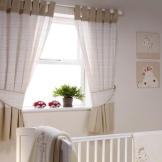
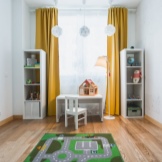
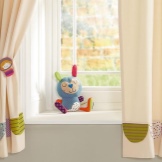
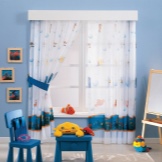
With age, children often want something bright and unusual. Of course, their vision of style often allows them to fill the space with fresh ideas and creativity. At the same time, someone prefers to rely on the calm tones and unusualness of the curtains themselves, while others leave the cut classic, but at the same time choose rather extraordinary designs (for example, graffiti). In such situations, in order not to get out of the general concept of stylistics, it is worth paying attention to the already existing accents in the interior. For example, if there are photo wallpapers on the walls of the nursery, photo curtains are not needed, even if their drawing is super modern. When the background design does not have a pattern, you can buy printed panels. Teens often figure out which is better, especially when it comes to choosing the type of models.And if for girls' rooms it can be French, Austrian curtains and some modern counterparts, the guys clearly know: you need a simple, but stylish and modern solution, which, despite the seeming brevity, will look cool.
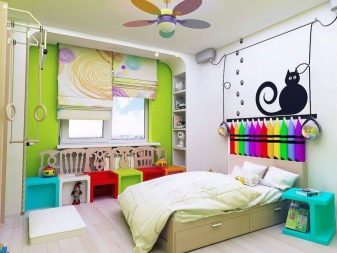
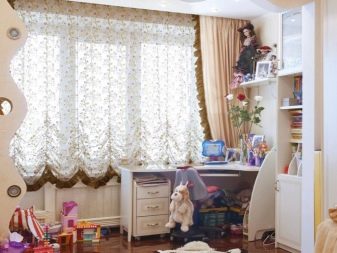
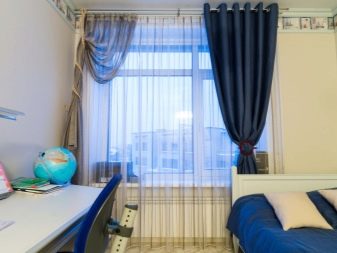

Successful examples in the interior
Finally, you can pay attention to several successful design ideas, clearly demonstrating a sense of taste and style in the interior of the nursery for boys and girls of different ages.
- A gentle solution for decorating a young girl's room.
- Green curtains in the girl's room fill the space with positive.
- White curtains visually blur the boundaries of the room, bringing a sense of lightness to the interior.
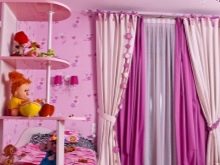

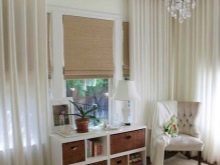
- Bright curtains bring a special flavor to the space of the teenage room.
- Yellow curtains fill the room with an atmosphere of warmth and home comfort.
- Blue curtains look good in bright rooms with the support of small interior accessories.
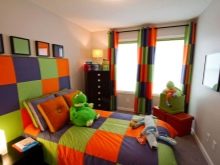
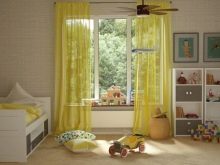

- An extraordinary solution for the interior of a teenage room using modern curtains.
- A harmonious choice of curtains for a teenage boy's room.
- Design of curtains for decorating the skylights of the nursery.

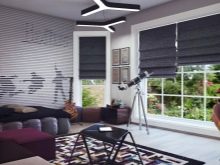
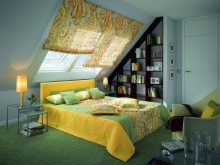
For tips on how to choose curtains for a bright, bright children's room with orange wallpaper on the walls, see the video.













The comment was sent successfully.